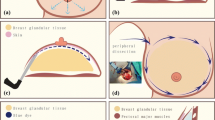Abstract
Objective
The aim of this study was to assess the success of tumor resection and its postoperative complications, satisfaction, and quality of life using a single-incision approach for breast-conserving surgery.
Materials and Methods
This was an observational, prospective study conducted between 2015 and 2018. The study group consisted of patients in whom tumor extirpation and lymph node (LN) staging was performed using a single incision, while the control group consisted of patients who underwent a breast-conserving procedure with independent incisions. All patients were given the preoperative and postoperative module of the Breast-Q™ questionnaire.
Results
Overall, 226 patients met the study’s inclusion criteria, 152 of whom successfully underwent breast and LN removal using a single-incision approach (98.7% overall success). There were no significant differences in postoperative complications, although there was a greater tendency towards breast seroma in the study group and axillary neuralgia in the control group. Both groups presented a similar rate of breast and axillary salvage surgery. The postoperative Breast-Q™ questionnaire showed that the study group had greater satisfaction with both the breast and the information provided by the surgeon.
Conclusion
The single-incision approach is as effective as standard surgery, with custom incisions in terms of breast resection, LN staging, and complications. There was greater satisfaction with both the breast and the information provided.


Similar content being viewed by others
References
Fisher B, Jeong J, Anderson S, Bryant J, Fisher E, Wolmark N. Twenty-five-year follow-up of a randomized trial comparing radical mastectomy, total mastectomy and total mastectomy followed by irradiation. N Engl J Med. 2002; 347:567–75.
Veronesi U, Luini A, Del Vecchio M. Radiotherapy after breast-preserving surgery in women with localized cancer of the breast. N Eng J Med. 1993; 328:1587–91.
Acea-Nebril B, Cereijo-Garea C, García-Novoa A, Varela-Lamas C et al. The role of oncoplastic breast reduction in the conservative management of breast cancer: complications, survival, and quality of life. J Surg Oncol. 2017;115(6):679–86.
Nabholtz JM, Chalabi N, Radosevic-Robin N et al. Multicentric neoadjuvant pilot Phase II study of cetuximab combined with docetaxel in operable triple negative breast cancer. Int J Cancer. 2016; 138(9):2274–80.
Giuliano AE, Ballman KV, McCall L et al. Effect of axillary dissection vs no axillary dissection on 10-year overall survival among women with invasive breast cancer and sentinel node metastasis: the ACOSOG Z0011 (Alliance) Randomized Clinical Trial. JAMA. 2017; 318(10):918–26.
Acea Nebril B. “Scarless” surgery in the treatment of breast cancer. Cir Esp. 2010; 87(4):210–7.
Spillane AJ, Brennan ME. Minimal access breast surgery: a single breast incision for breast conservation surgery and sentinel lymph node biopsy. Eur J Surg Oncol. 2009; 35(4):380–6.
Cocilovo C, Boolbol SK, Valdes E, Feldman S. Less is more: transmammary axillary lymph node evaluation: an initial clinical experience. Am J Surg. 2006; 192(4):478–80.
Ozaki S, Ohara M. Endoscopy-assisted breast-conserving surgery for breast cancer patients. Gland Surg. 2014; 3(2):94–108.
Saimura M, Mitsuyama S, Anan K et al. Endoscopy-assisted breast-conserving surgery for early breast cancer. Asian J Endosc Surg. 2013; 6(3):203–8.
Clough KB, Kaufman GJ, Nos C, Buccimazza I, Safarti IM. Improving breast cancer surgery: a classification and quadrant per quadrant atlas for oncoplastic surgery. Ann Surg Oncol. 2010; 17(5):1375–91.
Mapi Research Trust, ePROVIDE™. BREAST-Q™. Available at: https://eprovide.mapi-trust.org/instruments/breast-q#basic_description
Yamashita K, Shimizu K. Transaxillary retromammary route approach of video-assisted breast surgery enables the inner-side breast cancer to be resected for breast conserving surgery. Am J Surg. 2008; 196(4):578–81.
Park HS, Lee JS, Lee JS, Park S, Kim SI, Park BW. The feasibility of endoscopy-assisted breast conservation surgery for patients with early breast cancer. J Breast Cancer. 2011; 14(1):52–7.
Lee EK, Kook SH, Park YL, Bae WG. Endoscopy-assisted breast-conserving surgery for early breast cancer. World J Surg. 2006; 30(6):957–64.
Iglesias M, Gonzalez-Chapa DR. Endoscopic latissimus dorsi muscle flap for breast reconstruction after skin-sparing total mastectomy: report of 14 cases. Aesthetic Plast Surg. 2013; 37(4):719–27.
Tukenmez M, Ozden BC, Agcaoglu O, Kecer M, Ozmen V, Muslumanoglu M, et al. Videoendoscopic single-port nipple-sparing mastectomy and immediate reconstruction. J Laparoendosc Adv Surg Tech A. 2014; 24(2):77–82.
Noguchi M, Inokuchi M, Ohno Y, Yokoi-Noguchi M, Nakano Y, Kosaka T. Oncological and cosmetic outcome in breast cancer patients undergoing “moving window” operation. Breast Cancer Res Treat. 2011; 129(3):849–56.
Noguchi M, Inokuchi M. “Moving window” operation for breast-conserving surgery. Breast Cancer. 2010; 17(1):56–60.
Leidenius M, Leppänen E, Krogerus L, von Smitten K. Motion restriction and axillary web syndrome after sentinel node biopsy and axillary clearance in breast cancer. Am J Surg. 2003; 185(2):127–30.
Moskovitz AH, Anderson BO, Yeung RS, Byrd DR, Lawton TJ, Moe RE. Axillary web syndrome after axillary dissection. Am J Surg. 2001; 181(5):434–9.
Acknowledgment
The authors would like to acknowledge all members of the Breast Unit, University Hospital Complex A Coruña, A Coruña, Spain.
Author information
Authors and Affiliations
Corresponding author
Additional information
Publisher's Note
Springer Nature remains neutral with regard to jurisdictional claims in published maps and institutional affiliations.
Rights and permissions
About this article
Cite this article
Acea-Nebril, B., García-Novoa, A., Cereijo-Garea, C. et al. Single-Incision Approach for Breast-Conserving Surgery: Effectiveness, Complications and Quality of Life. Ann Surg Oncol 26, 2466–2474 (2019). https://doi.org/10.1245/s10434-019-07443-3
Received:
Published:
Issue Date:
DOI: https://doi.org/10.1245/s10434-019-07443-3




